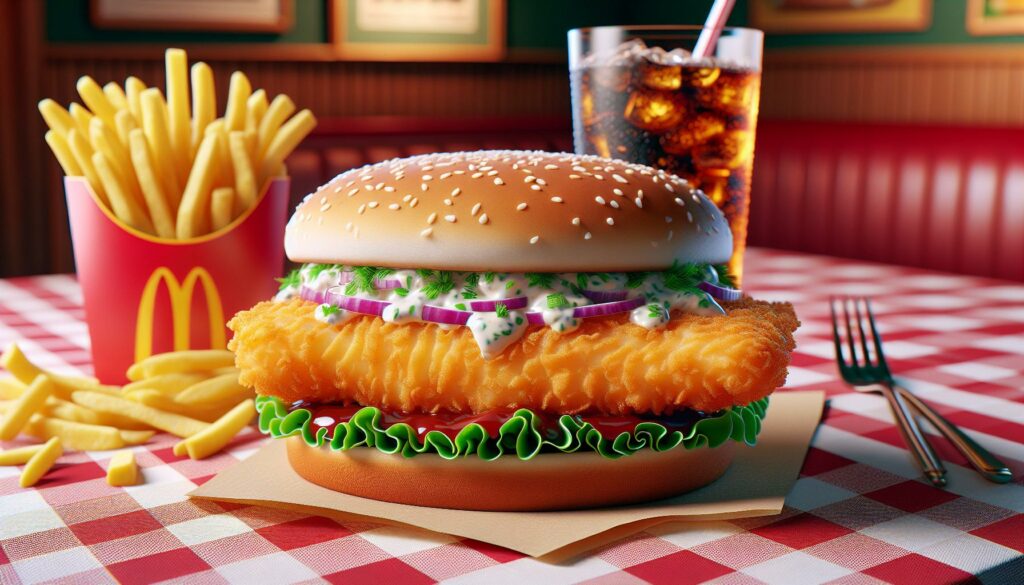”
When I think of fast food, McDonald’s often comes to mind, especially their iconic menu items. One option that intrigues many is the fish sandwich. It’s a popular choice for those looking to switch things up from the usual burgers and fries. But how does it stack up nutritionally?
In this article, I’ll dive into the nutritional aspects of McDonald’s fish sandwich. From calorie counts to key ingredients, I’ll break down what you need to know before indulging. Whether you’re a health-conscious eater or just curious about your favorite fast food, understanding the nutrition behind this sandwich can help you make informed choices. Let’s explore what’s really in that crispy, golden bun.
- Nutritional Breakdown: McDonald’s Fish Sandwich contains 390 calories, 19g of total fat, and offers 15g of protein, making it a moderately nutritious fast food choice.
- Primary Ingredients: The sandwich features a breaded Alaskan Pollock fillet, tartar sauce, shredded lettuce, and a sesame seed bun, which contribute to its overall nutritional profile.
- Vitamins and Minerals: It provides essential nutrients, including calcium, iron, vitamin A, and vitamin C, supporting overall health.
- Dietary Considerations: The sandwich is not suitable for individuals with seafood allergies or those following vegetarian or vegan diets due to its fish content.
- Sustainability Commitment: McDonald’s Fish Sandwich is sourced from Alaskan Pollock, certified by the Marine Stewardship Council, reflecting the company’s dedication to sustainable fishing practices.
- Comparison to Other Menu Items: With lower calories than items like a Big Mac and comparable sodium levels to Chicken McNuggets, the Fish Sandwich serves as a lighter fast-food option.
McDonald’s Fish Sandwich Nutrition
mcdonald’s fish sandwich nutrition features a breaded fish fillet, typically made from Alaskan Pollock. This sandwich includes tartar sauce, shredded lettuce, and a sesame seed bun. Knowing the nutritional breakdown allows for better meal choices.
Nutritional Information
Here’s a table summarizing the nutritional components of the Fish Sandwich:
| Nutrient | Amount Per Serving |
|---|---|
| Calories | 390 |
| Total Fat | 19g |
| Saturated Fat | 3.5g |
| Trans Fat | 0g |
| Cholesterol | 40mg |
| Sodium | 560mg |
| Total Carbohydrates | 39g |
| Dietary Fiber | 2g |
| Sugars | 3g |
| Protein | 15g |
- Fish Fillet: The primary protein source, provides beneficial omega-3 fatty acids.
- Bun: Offers carbohydrates for quick energy.
- Tartar Sauce: Adds flavor but increases calorie and fat content.
- Lettuce: Contributes vitamins while adding a crunchy texture.
Understanding these elements helps assess how this sandwich fits into one’s diet. The Fish Sandwich serves as a seafood option for those seeking variety in fast food.
Nutritional Information
I’ll provide a detailed nutritional overview of McDonald’s fish sandwich, including calorie counts, macronutrient content, and essential vitamins and minerals.
Calories and Serving Size
The mcdonald’s fish sandwich nutrition contains 390 calories per serving. The serving size typically includes one sandwich, which consists of a breaded fish fillet, tartar sauce, shredded lettuce, and a sesame seed bun. Recognizing portion sizes helps in managing overall calorie intake.
Macronutrients Breakdown
The macronutrient composition of the fish sandwich is as follows:
| Macronutrient | Amount |
|---|---|
| Total Fat | 19g |
| Saturated Fat | 3.5g |
| Trans Fat | 0g |
| Cholesterol | 50mg |
| Sodium | 560mg |
| Total Carbohydrates | 38g |
| Dietary Fiber | 1g |
| Sugars | 5g |
| Protein | 15g |
The fish fillet provides protein and essential omega-3 fatty acids, while the bun contributes carbohydrates for energy. The tartar sauce adds fat and extra calories, enhancing flavor but increasing total fat intake.
Vitamins and Minerals
The fish sandwich offers several vitamins and minerals, enhancing its nutritional profile:
| Vitamin/Mineral | Amount |
|---|---|
| Calcium | 150mg |
| Iron | 1.2mg |
| Vitamin A | 400IU |
| Vitamin C | 2mg |
These nutrients contribute to overall health, supporting various bodily functions. The fish sandwich serves as a seafood option, incorporating some essential micronutrients into the diet.
Health Considerations
Understanding the health implications of mcdonald’s fish sandwich nutrition assists in making informed dietary choices. Key aspects to consider include comparisons with other menu items and potential dietary restrictions.
Comparison with Other Menu Items
Comparing McDonald’s Fish Sandwich with other menu items reveals differences in calories and macronutrients. The Fish Sandwich contains 390 calories, 19g of total fat, and 15g of protein. In contrast, a regular cheeseburger has 300 calories and 12g of fat, while a Big Mac contains 550 calories and 30g of fat. These comparisons show that the Fish Sandwich offers a lower-calorie alternative, appealing to those seeking lighter options. However, its sodium content, at 560mg, is comparable to other items like the Chicken McNuggets, which contain 440mg per 6-piece serving. This analysis aids in understanding how the Fish Sandwich fits into a broader dietary context.
Dietary Restrictions
Addressing dietary restrictions is crucial when considering the Fish Sandwich. This item contains fish, a common allergen for some individuals. It’s essential for those with seafood allergies to avoid this sandwich. Additionally, individuals following vegetarian or vegan diets should note that the Fish Sandwich is not suitable for their lifestyle, as it contains animal products. The breading may also include gluten, making it a poor choice for those with gluten sensitivities. The presence of mayonnaise in tartar sauce adds additional calories and fats, further complicating choices for those monitoring cholesterol or fat intake. Recognizing these factors ensures a better alignment of dietary choices with individual health needs.
Sustainability and Sourcing
McDonald’s prioritizes sustainability and responsible sourcing in providing quality ingredients for its Fish Sandwich. The fish fillet typically comes from Alaskan Pollock, a species certified by the Marine Stewardship Council, ensuring environmentally responsible fishing practices.
McDonald’s emphasizes using sustainable seafood suppliers. Commitments include tracing the fish’s journey from ocean to plate. This traceability ensures adherence to strict standards concerning conservation and fishing methods. McDonald’s has also pledged to source 100% of its fish from certified, sustainable fisheries.
In addition, McDonald’s sources components like lettuce and buns from suppliers committed to sustainable agricultural practices. By focusing on farmers who practice responsible land use and wildlife protection, the company aims to minimize the environmental impact of sourcing these ingredients.
Overall, McDonald’s commitment to sustainability in sourcing reflects an effort to promote environmentally friendly practices in the fast-food industry while providing customers with a seafood options that aligns with their values.
McDonald’s Fish Sandwich
Choosing mcdonald’s fish sandwich nutrition can be a tasty way to mix up your fast food routine while still keeping an eye on nutrition. With its balance of protein and beneficial omega-3 fatty acids it offers a seafood option that many enjoy.
However it’s essential to consider the sodium content and the presence of allergens like fish and gluten. For those mindful of their dietary choices understanding these aspects can help you make informed decisions.
Additionally McDonald’s commitment to sustainability adds another layer of appeal for environmentally conscious diners. Overall this sandwich stands out as a flavorful alternative that fits within a balanced diet.

